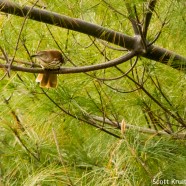August Common Buckeye
This Common Buckeye (Junonia coenia) posed nicely for me yesterday. It looked a little tattered around the edges, and had lost some of the uniformity of its shades, but still held most of the vibrant colors of its species here in mid-August. They are such beautiful creatures, oh my… Scott Kruitbosch Conservation & Outreach Coordinator
Read MoreBrown Thrasher
This Brown Thrasher (Toxostoma rufum) has been avoiding my camera for at least two weeks now. It may have a mate, but I never end up spotting any true signs of probable nesting, and certainly lack any confirmations thus far. Sadly it is a far more notable sighting than it was back in Roger Tory Peterson’s day in the Northeast. The species has dropped dramatically in abundance, and what used to be a common breeding bird for many is now a ghost in behavior and population. I am still always startled by how boldly patterned, uniquely shaped, and even loudly musical they can be, yet often...
Read MoreMelanistic House Sparrow (Passer domesticus)
This is one House Sparrow (Passer domesticus) I have never seen before! I took these shots last weekend, the bird being part of a group of well over 100 House Sparrows. The photos are very true to real life appearance and have not been heavily edited. Do you know why it is so dark? It appears to be melanistic which means that the dark-colored pigment melanin in the feathers was produced at higher than normal levels creating an abnormal color. The opposite is known as leucism where pigments are produced at less than normal levels or in an unexpected pattern. Melanism in small songbirds is...
Read MoreLong-tailed Ducks (Clangula hyemalis)
It is December duck time! I have been enjoying some of the new arrivals across our region as birds like Red-breasted Mergansers, Common Goldeneyes, Greater and Lesser Scaups, Ring-necked Ducks, Redheads, and these Long-tailed Ducks make their way to our shores. This species of diving duck certainly spends a long time underwater when it is feeding. It can even go down to near 200 feet! Their incredible patterns almost appeared camouflaged against the water on this cloudy late autumn day. Scott Kruitbosch Conservation & Outreach Coordinator
Read MoreDark-eyed Junco (Junco hyemalis)
Have “your” Dark-eyed Juncos (Junco hyemalis) returned yet? While many of us in the Chautauqua-Allegheny region have them year-round there are millions upon millions more pouring into our yards now, readying to dine at your place all winter. Juncos can be so variable in pattern and are always a lot of fun to study on a frigid, snowy day. In the past I have particularly enjoyed seeing some with eye rings and others with wing bars! Scott Kruitbosch Conservation & Outreach Coordinator
Read More








